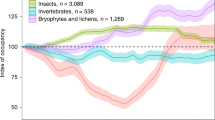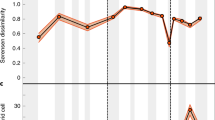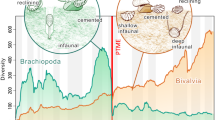Abstract
The fossil record preserves numerous natural experiments that can shed light on the response of ecological communities to environmental change. However, directly observing the community dynamics of extinct organisms is not possible. As an alternative, neutral ecological models1,2,3 suggest that species abundance distributions reflect dynamical processes like migration, competition, recruitment, and extinction. Live–dead comparisons suggest that such distributions can be faithfully preserved in the rock record4. Here we use a maximum-likelihood approach to show that brachiopod (lamp shell) abundance distributions from four temporally distinct ecological landscapes from the Glass Mountains, Texas (of the Permian period), exhibit significant differences. Further, all four are better fitted by zero-sum multinomial distributions, characteristic of Hubbell's neutral model2, than by log-normal distributions, as predicted by the traditional ecological null hypothesis5. Using the neutral model as a guide, we suggest that sea level fluctuations spanning about 10 Myr altered the degrees of isolation and exchange among local communities within these ecological landscapes. Neither these long-term environmental changes nor higher-frequency sea level fluctuations resulted in wholesale extinction or major innovation within evolutionary lineages.
This is a preview of subscription content, access via your institution
Access options
Subscribe to this journal
Receive 51 print issues and online access
$199.00 per year
only $3.90 per issue
Buy this article
- Purchase on Springer Link
- Instant access to full article PDF
Prices may be subject to local taxes which are calculated during checkout



Similar content being viewed by others
References
Hughes, R. G. A model of the structure and dynamics of benthic marine invertebrate communities. Mar. Ecol. Prog. Ser. 15, 1–11 (1984)
Hubbell, S. P. The Unified Neutral Theory of Biodiversity and Biogeography (Princeton Univ. Press, Princeton, New Jersey, 2001)
Bell, G. Neutral macroecology. Science 293, 2413–2418 (2001)
Kidwell, S. M. Preservation of species abundance in marine death assemblages. Science 294, 1091–1094 (2001)
McGill, B. J. A test of the unified neutral theory of biodiversity. Nature 422, 881–885 (2003)
Cooper, G. A. & Grant, R. E. Permian Brachiopods of West Texas I 1–231 (Smithsonian Contributions to Paleobiology 14, Smithsonian Institution Press, Washington DC, 1972)
Cooper, G. A. & Grant, R. E. Permian Brachiopods of West Texas, II, 233–793 (Smithsonian Contributions to Paleobiology 15, Smithsonian Institution Press, Washington DC, 1974)
Cooper, G. A. & Grant, R. E. Permian Brachiopods of West Texas, III, 795–1921 (Smithsonian Contributions to Paleobiology 19, Smithsonian Institution Press, Washington DC, 1975)
Cooper, G. A. & Grant, R. E. Permian Brachiopods of West Texas, IV, 1923–2607 (Smithsonian Contributions to Paleobiology 21, Smithsonian Institution Press, Washington DC, 1976)
Cooper, G. A. & Grant, R. E. Permian Brachiopods of West Texas, V, 2609–3159 (Smithsonian Contributions to Paleobiology 24, Smithsonian Institution Press, Washington DC, 1976)
Cooper, G. A. & Grant, R. E. Permian Brachiopods of West Texas, VI, 3161–3370 (Smithsonian Contributions to Paleobiology 32, Smithsonian Institution Press, Washington DC, 1977)
Sarg, J. F. & Lehmann, P. J. in Lower and Middle Guadalupian Facies, Stratigraphy, and Reservoir Geometries, San Andres/Grayburg Formations, Guadalupe Mountains, New Mexico and Texas (eds Moore, G. & Wilde, G.) 1–8 (SEPM Permian Basin Section, Tulsa, Oklahoma, 1986)
Sarg, J. F., Markello, J. R. & Weber, L. J. in Advances in Carbonate Sequence Stratigraphy: Applications to Reservoirs, Outcrops, and Models (eds Harris, P. M., Saller, A. H. & Simo, J. A.) 11–34 (Society for Sedimentary Geology (SEPM), Tulsa, Oklahoma, 1999)
Carroll, M., Kowalewski, M., Simoes, M. G. & Goodfriend, G. A. Quantitative estimates of time-averaging in terebratulid brachiopod shell accumulations from a modern tropical shelf. Paleobiology 29, 381–402 (2003)
Sugihara, G., Bersier, L.-F., Southwood, T. R. E., Pimm, S. L. & May, R. M. Predicted correspondence between species abundances and dendrograms of niche similarities. Proc. Natl Acad. Sci. USA 100, 5246–5251 (2003)
Volkov, I., Banavar, J. R., Hubbell, S. P. & Maritan, A. Neutral theory and relative species abundance in ecology. Nature 424, 1035–1037 (2003)
McKane, A. J., Alonso, D. & Sole, R. V. Analytic solution of Hubbell's model of local community dynamics. Theor. Pop. Biol. 65, 67–73 (2004)
Clark, J. S. & MacLachlan, J. S. Stability of forest biodiversity. Nature 423, 635–638 (2003)
Fargione, J., Brown, C. S. & Tilman, D. Community assembly and invasion: An experimental test of neutral versus niche processes. Proc. Natl Acad. Sci. USA 100, 8916–8920 (2003)
Preston, F. W. The commonness and rarity of species. Ecology 29, 254–283 (1948)
May, R. M. in Ecology and Evolution of Communities (eds Cody, M. L. & Diamond, J. M.) 81–120 (Belknap, Cambridge, Massachusetts, 1975)
Routledge, R. D. The form of species-abundance distributions. J. Theor. Biol. 82, 547–558 (1980)
Rohr, D. M. et al. in The Guadalupian Symposium (eds Wardlaw, B. R., Grant, R. E. & Rohr, D. M.) 5–36 (Smithsonian Contributions to the Earth Sciences 32, Smithsonian Institution Press, Washington DC, 2000)
Wardlaw, B. R., Ross, C. A. & Grant, R. E. in The Guadalupian Symposium (eds Wardlaw, B. R., Grant, R. E. & Rohr, D. M.) 121–126 (Smithsonian Contributions to the Earth Sciences 32, Washington DC, 2000)
Wardlaw, B. R. in The Guadalupian Symposium (eds Wardlaw, B. R., Grant, R. E. & Rohr, D. M.) 37–87 (Smithsonian Contributions to the Earth Sciences 32, Smithsonian Institution Press, Washington DC, 2000)
Harris, M. T., Lehrmann, D. J. & Lambert, L. L. in The Guadalupian Symposium (eds Wardlaw, B. R., Grant, R. E. & Rohr, D. M.) 153–173 (Smithsonian Contributions to the Earth Sciences 32, Smithsonian Institution Press, Washington, DC, 2000)
Nee, S., Harvey, P. H. & May, R. M. Lifting the veil on abundance patterns. Proc. R. Soc. Lond. B 243, 161–163 (1991)
Hilborn, R. & Mangel, M. The Ecological Detective: Confronting Models with Data (Princeton Univ. Press, Princeton, New Jersey, 1997)
Bowring, S. A. et al. U/ Pb zircon geochronology and tempo of the end-Permian mass extinction. Science 280, 1039–1045 (1998)
Jin, Y., Wardlaw, B. R., Glenister, B. F. & Kotlyar, C. V. Permian chronostratigraphic subdivisions. Episodes 20, 10–15 (1997)
Acknowledgements
We thank A. I. Miller and M. Foote for comments.This research was supported by the Walcott Fund of the Department of Paleobiology of the Smithsonian Institution and the NASA Astrobiology Institute.
Author information
Authors and Affiliations
Corresponding author
Ethics declarations
Competing interests
The authors declare that they have no competing financial interests.
Supplementary information
Supplementary Information
Includes information on: ecological relationships among sequences; the effect of combining communities over evolutionary timescales. (PDF 116 kb)
Rights and permissions
About this article
Cite this article
Olszewski, T., Erwin, D. Dynamic response of Permian brachiopod communities to long-term environmental change. Nature 428, 738–741 (2004). https://doi.org/10.1038/nature02464
Received:
Accepted:
Issue Date:
DOI: https://doi.org/10.1038/nature02464
This article is cited by
-
The two phases of the Cambrian Explosion
Scientific Reports (2018)
-
Emergent neutrality leads to multimodal species abundance distributions
Nature Communications (2012)
-
Predation on two brachiopods, Joania cordata and Argyrotheca cuneata, from an offshore reef in the Tyrrhenian Sea
Marine Biology (2012)
-
Relative roles of niche and neutral processes in structuring a soil microbial community
The ISME Journal (2010)
-
Brachiopods from cryptic coral reef habitats in the northern Red Sea
Facies (2009)
Comments
By submitting a comment you agree to abide by our Terms and Community Guidelines. If you find something abusive or that does not comply with our terms or guidelines please flag it as inappropriate.



